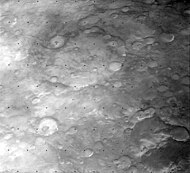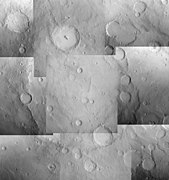
Mädler is a crater on Mars. It was named in honor of the German astronomer Johann Heinrich Mädler by the IAU in 1973.

Holden is a 140 km wide crater situated within the Margaritifer Sinus quadrangle (MC-19) region of the planet Mars, located with the southern highlands. It is named after American astronomer Edward Singleton Holden. It is part of the Uzboi-Landon-Morava (ULM) system.

Uzboi Vallis is a valley lying situated within the Margaritifer Sinus quadrangle (MC-19) region on Mars. It is named after the Uzboy dry channel, now in Turkmenistan, which repeatedly served as the main channel of the Amu Darya river. The valley begins on the northern rim of the Argyre basin, and cuts through several craters, before ending at Holden crater.
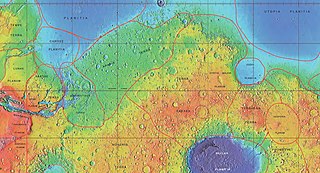
Arabia Terra is a large upland region in the north of Mars that lies mostly in the Arabia quadrangle, but a small part is in the Mare Acidalium quadrangle. It is densely cratered and heavily eroded. This battered topography indicates great age, and Arabia Terra is presumed to be one of the oldest terrains on the planet. It covers as much as 4,500 km (2,800 mi) at its longest extent, centered roughly at 21°N6°E with its eastern and southern regions rising 4 km (13,000 ft) above the north-west. Alongside its many craters, canyons wind through the Arabia Terra, many emptying into the large northern lowlands of the planet, which borders Arabia Terra to the north.

Eberswalde, formerly known as Holden NE, is a partially buried impact crater in Margaritifer Terra, Mars. Eberswalde crater lies just to the north of Holden, a large crater that may have been a lake. The 65.3-km-diameter crater, centered at 24°S, 33°W, is named after the German town of the same name, in accordance with the International Astronomical Union's rules for planetary nomenclature. It was one of the final four proposed landing sites for the Mars rover Mars Science Laboratory mission. This extraterrestrial geological feature lies situated within the Margaritifer Sinus quadrangle (MC-19) region of Mars. Although not chosen, it was considered a potential landing site for the Mars 2020 Perseverance rover, and in the second Mars 2020 Landing Site Workshop it survived the cut and was among the top eight sites still in the running.
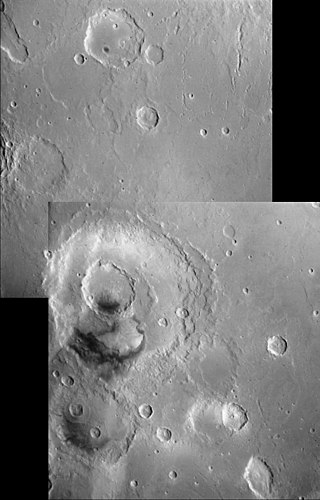
Becquerel is a 167 km-diameter crater at 22.1°N, 352.0°E on Mars, in Arabia Terra in Oxia Palus quadrangle. It is named after Antoine H. Becquerel.

The Arabia quadrangle is one of a series of 30 quadrangle maps of Mars used by the United States Geological Survey (USGS) Astrogeology Research Program. The Arabia quadrangle is also referred to as MC-12.

The Margaritifer Sinus quadrangle is one of a series of 30 quadrangle maps of Mars used by the United States Geological Survey (USGS) Astrogeology Research Program. The Margaritifer Sinus quadrangle is also referred to as MC-19. The Margaritifer Sinus quadrangle covers the area from 0° to 45° west longitude and 0° to 30° south latitude on Mars. Margaritifer Sinus quadrangle contains Margaritifer Terra and parts of Xanthe Terra, Noachis Terra, Arabia Terra, and Meridiani Planum.

The Thaumasia quadrangle is one of a series of 30 quadrangle maps of Mars used by the United States Geological Survey (USGS) Astrogeology Research Program. The Thaumasia quadrangle is also referred to as MC-25 . The name comes from Thaumas, the god of the clouds and celestial apparitions.

Trouvelot is a crater on Mars, located in the Oxia Palus quadrangle at 16.2° north latitude and 13.1° west longitude near the crustal dichotomy in the circum-Chryse region. It is roughly located along the dichotomy between Arabia Terra to the northeast and the southernmost of the circum-Chryse outflow channels to the southwest. Trouvelot crater measures approximately 148.77 kilometres (92.44 mi) in diameter and was named after Étienne Léopold Trouvelot, a French astronomer (1827–1895). The name was adopted by IAU's Working Group for Planetary System Nomenclature in 1973.

Wislicenus is an impact crater on Mars, located in the Sinus Sabaeus quadrangle at 18.4° south latitude and 348.6° west longitude. It measures approximately 140.15 km (87.09 mi) in diameter and was named after German astronomer Walter Wislicenus (1859–1905). The name was adopted by the IAU in 1973.
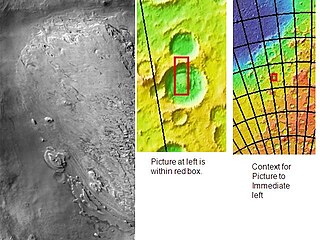
Spallanzani is a crater on Mars, located in the Hellas quadrangle at 58.0° south latitude and 86.4° east longitude. It measures 71.69 kilometres (44.55 mi) in diameter, and was named after Italian biologist Lazzaro Spallanzani (1729–1799). The name was adopted by IAU's Working Group for Planetary System Nomenclature in 1973.

Tikhonravov is a large, eroded crater in the Arabia quadrangle of Mars. It is 344 kilometres (214 mi) in diameter and was named after Mikhail Tikhonravov, a Russian rocket scientist. Tikhonravov is believed to have once held a giant lake that drained into the 4,500-kilometre-long (2,800 mi) Naktong-Scamander-Mamers lake-chain system. An inflow and outflow channel has been identified. Many craters once contained lakes.
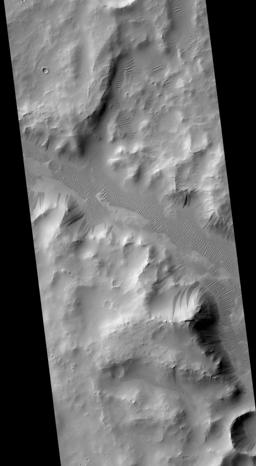
Naktong Vallis is an ancient river valley in the Arabia quadrangle of Mars, located at 5.3 degrees north latitude and 327.1 degrees west longitude. It is 670 km long and was named after the Nakdong River in Korea.

Rain and snow were regular occurrences on Mars in the past; especially in the Noachian and early Hesperian epochs. Water was theorized to seep into the ground until it reached a formation that would not allow it to penetrate further. Water then accumulated forming a saturated layer. Deep aquifers may still exist.

Arago is an impact crater in the Arabia quadrangle on Mars at 10.22 N and 29.93° E. It is 152 km (94 mi) in diameter and is in the northernmost part of Terra Sabaea. Its name was approved in 1973 and refers to the French astronomer François Arago.

Danielson is an impact crater in the Oxia Palus quadrangle on Mars at 7.93° N and 7.11° W. and is 66.7 km in diameter, and is north of the Meridiani Planum, south of Arabia Terra. Its name was approved in 2009, and it was named after American engineer G. Edward Danielson.

Janssen Crater is an impact crater in the Arabia quadrangle on Mars at 2.7° N and 322.4° W. and is 154 km in diameter. Its name was approved in 1973, and refers to French astronomer Pierre Janssen. Some close up images of the crater reveal layers in a floor deposit. A picture below show these layers, as well as dark slope streaks. The darker the streak, the younger it is. The layers on the floor of Janssen may have been formed on the bottom of lakes.
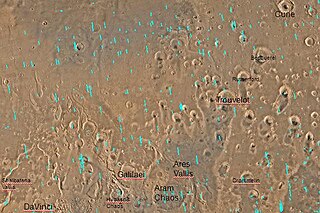
Crommelin is an impact crater in the Oxia Palus quadrangle of Mars, located at 5.1°N latitude and 10.2°W longitude. It is 113.9 km in diameter. It was named after British astronomer Andrew Crommelin (1865–1939), and the name was approved in 1973 by the International Astronomical Union (IAU) Working Group for Planetary System Nomenclature (WGPSN).

In summer 1965, the first close-up images from Mars showed a cratered desert with no signs of water. However, over the decades, as more parts of the planet were imaged with better cameras on more sophisticated satellites, Mars showed evidence of past river valleys, lakes and present ice in glaciers and in the ground. It was discovered that the climate of Mars displays huge changes over geologic time because its axis is not stabilized by a large moon, as Earth's is. Also, some researchers maintain that surface liquid water could have existed for periods of time due to geothermal effects, chemical composition, or asteroid impacts. This article describes some of the places that could have held large lakes.

